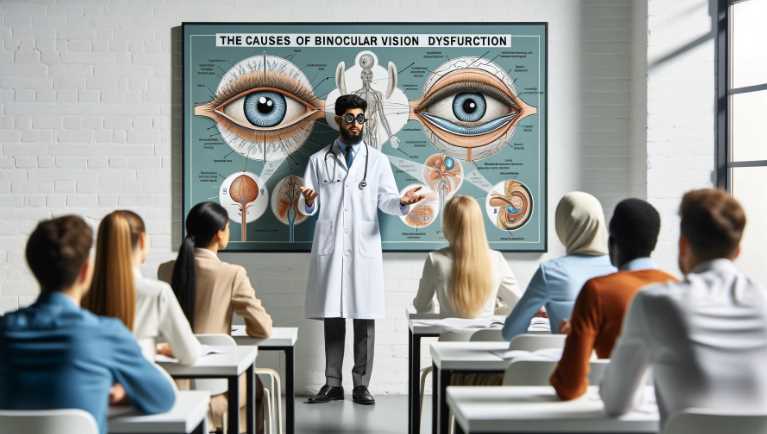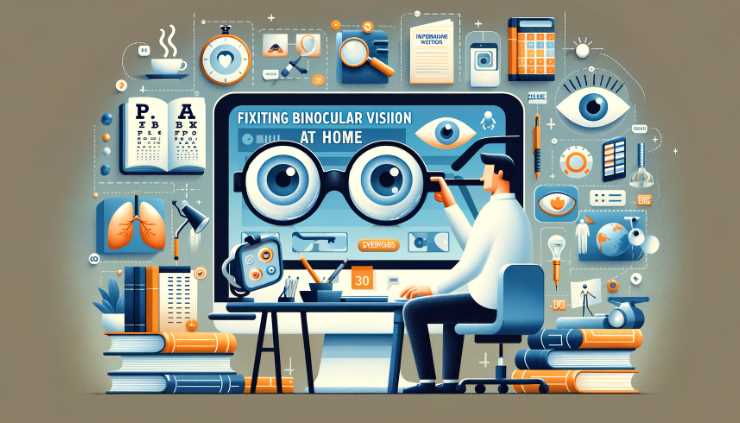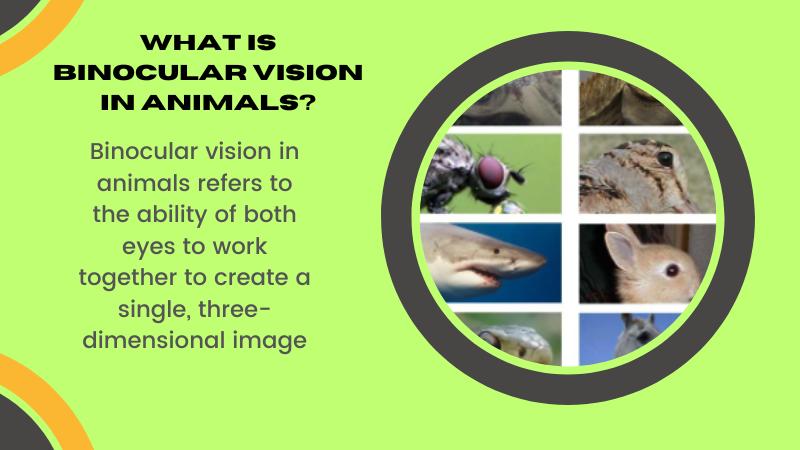Binocular vision dysfunction can be caused by various factors, including:
- Muscular Imbalance:
- Weakness or imbalance in the eye muscles that control eye movements and alignment.
- Refractive Errors:
- Discrepancies in each eye’s prescription, such as nearsightedness, farsightedness, or astigmatism.
- Strabismus:
- Misalignment of the eyes, where one eye may turn inward, outward, upward, or downward.
- Convergence Insufficiency:
- Difficulty in coordinating both eyes to converge and focus on a near object.
- Accommodative Dysfunction:
- Impaired ability of the eyes to adjust focus between near and far objects.
- Eye Disorders or Diseases:
- Conditions like amblyopia (lazy eye), cataracts, or retinal problems can affect binocular vision.
- Trauma or Injury:
- Head injuries or trauma to the eye area can disrupt normal binocular vision function.
- Neurological Factors:
- Disorders such as multiple sclerosis or cranial nerve palsies affect the nervous system.

Binocular vision dysfunction occurs when there is a disruption in the precise coordination of both eyes, impairing their ability to work together effectively. The causes can be classified into issues related to eye muscles, refractive errors, eye misalignment, problems with convergence and accommodation, eye disorders or diseases, traumatic events, and neurological conditions.
| Cause | Description |
|---|---|
| Muscular Imbalance | Weakness or imbalance in eye muscles |
| Refractive Errors | Nearsightedness, farsightedness, astigmatism |
| Strabismus | Misalignment of eyes |
| Convergence Insufficiency | Difficulty in converging eyes for near vision |
| Accommodative Dysfunction | Impaired focus adjustment between near and far objects |
| Eye Disorders or Diseases | Amblyopia, cataracts, retinal problems |
| Trauma or Injury | Head injuries or trauma to the eye area |
| Neurological Factors | Disorders affecting the nervous system (e.g., multiple sclerosis, cranial nerve palsies) |
Common Signs and Symptoms of BVD
Binocular Vision Dysfunction (BVD) manifests through a variety of signs and symptoms that often go unnoticed or are mistakenly attributed to other causes. Recognizing these indicators is crucial for early detection and intervention. Let’s delve into the common signs that might signal the presence of BVD.
Double Vision and its Variations
Double vision, or diplopia, is a hallmark symptom of BVD. This occurs when the eyes fail to work together, causing two images to be perceived instead of one. The severity of double vision can vary, from subtle ghosting to distinct, overlapping images. Personally, experiencing double vision was disorienting, making it challenging to engage in activities requiring precise visual coordination.
Eye Strain and Discomfort
Eye strain is a pervasive symptom among individuals with BVD. Prolonged periods of reading, using digital screens, or engaging in visually demanding tasks can lead to discomfort, headaches, and an overall feeling of fatigue. I recall the persistent strain I felt during activities that demanded sustained visual focus, prompting me to seek relief through frequent breaks.
Headaches and Migraines Related to BVD
BVD often contributes to recurrent headaches and migraines. The strain on the eye muscles, particularly those responsible for alignment and coordination, can trigger tension headaches. The connection between visual stress and headaches became evident in my experience, emphasizing the interconnected nature of the eyes and overall head health.
Impact on Reading and Other Visual Tasks
The impact of BVD on reading and other visual tasks cannot be overstated. Individuals with BVD may encounter difficulties in maintaining focus on written text, leading to slower reading speeds and comprehension issues. Additionally, tasks that demand accurate depth perception, such as driving or playing sports, can be challenging. Personally, these challenges in reading and daily activities highlighted the pervasive influence of BVD on multiple aspects of life.
To provide a clearer overview, let’s summarize the common signs and symptoms of BVD in a table:
| Signs and Symptoms | Description |
|---|---|
| Double Vision | Perception of two images instead of one, varying in intensity. |
| Eye Strain and Discomfort | Discomfort, fatigue, and headaches during or after visually demanding tasks. |
| Headaches and Migraines | Recurrent headaches, often tension-related, associated with the strain on eye muscles. |
| Impact on Reading and Tasks | Difficulties in maintaining focus while reading, slower reading speeds, and challenges in tasks requiring depth perception. |
Causes of Binocular Vision Dysfunction
Understanding the causes of Binocular Vision Dysfunction (BVD) is essential for effective management and treatment. BVD can arise from various factors, each contributing to the intricate web of visual challenges. Let’s explore these causes in detail.
Refractive Errors
Refractive errors, such as myopia (nearsightedness), hyperopia (farsightedness), and astigmatism, play a significant role in the development of BVD. In my case, uncorrected refractive errors were at the core of my visual struggles. The table below illustrates the relationship between refractive errors and their impact on BVD.
| Refractive Error | Impact on BVD |
|---|---|
| Myopia | Difficulty in focusing on distant objects. |
| Hyperopia | Challenges in focusing on close-up tasks. |
| Astigmatism | Blurred or distorted vision due to irregular cornea. |
Ocular Misalignment
Ocular misalignment, characterized by conditions like strabismus and amblyopia, can disrupt the harmonious function of the eyes. Personally, the misalignment of my eyes was a revelation when it came to understanding BVD. The following table outlines the relationship between ocular misalignment and its impact on BVD.
| Ocular Condition | Impact on BVD |
|---|---|
| Strabismus | Eyes do not align properly, leading to double vision. |
| Amblyopia | Lazy eye, affecting visual acuity in one eye. |
Convergence Insufficiency
Convergence insufficiency is a specific condition where the eyes struggle to converge on a single point. This can contribute significantly to BVD symptoms. In my journey, recognizing this aspect of BVD was pivotal. The table below illustrates the relationship between convergence insufficiency and its impact on BVD.
| Convergence Insufficiency | Impact on BVD |
|---|---|
| Difficulty Converging | Strain and discomfort during close-up tasks, leading to eye fatigue. |
Accommodative Dysfunction
Accommodative dysfunction refers to difficulties in adjusting the focus of the eyes. This condition adds another layer to the complexity of BVD. In my experience, it explained the challenges I faced in maintaining clear vision. The table below outlines the relationship between accommodative dysfunction and its impact on BVD.
| Accommodative Dysfunction | Impact on BVD |
|---|---|
| Focusing Difficulties | Blurred vision, especially during close-up tasks. |
Neurological Factors
Neurological factors can contribute to BVD, emphasizing the intricate connection between the brain and the eyes. Understanding this connection provided insights into the broader scope of my visual challenges. The table below illustrates the relationship between neurological factors and their impact on BVD.
| Neurological Factors | Impact on BVD |
|---|---|
| Brain-related Issues | Disruption in the communication between the eyes and brain. |
By comprehending these causes and their interplay, individuals and eye care professionals can tailor interventions to address the specific factors contributing to Binocular Vision Dysfunction. Recognizing the nuances of these causes is key to unlocking effective solutions for improved visual health.
Diagnosis of Binocular Vision Dysfunction
Reaching a precise diagnosis for Binocular Vision Dysfunction (BVD) involves a comprehensive eye examination, employing specialized tests to unravel the intricacies of visual challenges. Early detection is paramount, allowing for targeted interventions. Let’s explore the diagnostic process through the following headings.
Comprehensive Eye Examination
A comprehensive eye examination is the foundational step in diagnosing BVD. This involves assessing visual acuity, refractive errors, and eye health. During this process, eye care professionals delve into the specific challenges impacting binocular vision.
Specialized Tests for BVD
Specialized tests play a pivotal role in pinpointing the nuances of BVD. These tests evaluate eye alignment, convergence, accommodation, and other factors contributing to binocular vision difficulties. The table below highlights key specialized tests used in the diagnosis of BVD.
| Specialized Test | Purpose in BVD Diagnosis |
|---|---|
| Cover Test | Evaluates eye alignment, detecting strabismus or misalignment. |
| Near Point of Convergence | Measures the ability of the eyes to converge on a close object. |
| Accommodative Testing | Assesses the eyes’ ability to focus on objects at varying distances. |
Importance of Early Detection
Early detection of BVD is crucial for effective intervention. Recognizing the signs and symptoms, coupled with a thorough eye examination, ensures that individuals receive timely and tailored care. This proactive approach minimizes the impact of BVD on daily activities and enhances the success of treatment strategies.
Treatment Options for Binocular Vision Dysfunction
Addressing Binocular Vision Dysfunction (BVD) involves a range of treatment options tailored to individual needs. From prescription glasses to specialized therapies, the goal is to enhance binocular vision. Let’s explore these treatment avenues through the following headings.
Prescription Glasses and Contact Lenses
Corrective lenses, such as glasses or contact lenses, offer a straightforward yet effective solution for refractive errors contributing to BVD. The table below outlines the role of prescription glasses in addressing specific refractive issues.
| Refractive Error | Prescription Solution |
|---|---|
| Myopia | Concave lenses to correct nearsightedness. |
| Hyperopia | Convex lenses to address farsightedness. |
| Astigmatism | Cylindrical lenses to correct distorted vision. |
Vision Therapy
Vision therapy involves a personalized program of exercises and activities designed to enhance eye coordination and functionality. It’s a hands-on approach to addressing the specific challenges identified through diagnostic tests.
Prism Glasses
Prism glasses are specialized lenses that alter the direction of light, helping to correct eye misalignment in conditions like strabismus. These glasses provide a unique solution to aligning the eyes and improving binocular vision.
Coping Strategies and Lifestyle Modifications
Navigating life with Binocular Vision Dysfunction (BVD) involves adopting practical coping strategies and lifestyle modifications. These adjustments aim to minimize eye strain and discomfort, ensuring a smoother daily experience. Let’s explore these strategies through the following headings.
Tips for Reducing Eye Strain
Implementing simple strategies, such as taking regular breaks during visually intensive tasks and maintaining adequate lighting, can significantly reduce eye strain. The table below summarizes key tips for minimizing eye strain associated with BVD.
| Coping Strategy | Description |
|---|---|
| Take Regular Breaks | Pause activities to rest the eyes and prevent fatigue. |
| Ensure Proper Lighting | Adequate lighting reduces strain during reading or screen use. |
Creating an Eye-Friendly Environment
Modifying the environment to accommodate visual needs is crucial. Simple adjustments, like proper screen placement and minimizing glare, contribute to a more comfortable and eye-friendly setting.
Importance of Regular Eye Check-ups
Regular eye check-ups ensure ongoing monitoring of BVD and prompt adjustments to treatment plans if needed. Consistent eye care is fundamental in managing and adapting to the challenges posed by BVD.
Can binocular vision dysfunction go away?

Yes, in many cases, binocular vision dysfunction can improve or even resolve. The outlook for recovery varies depending on factors such as the severity of the dysfunction, the underlying causes, and the timeliness of intervention. Early detection and appropriate measures, such as prescribed exercises and lifestyle adjustments, can significantly contribute to improvement.
What creates binocular vision?
Binocular vision is created by the coordinated functioning of both eyes and the brain. Each eye captures a slightly different image, and the brain combines these images to form a single, three-dimensional perception of the surrounding environment. Binocular vision relies on the precise coordination of eye movements, alignment, and focus.
What are the triggers for BVD?
Binocular Vision Dysfunction can have various triggers, including genetic factors, developmental issues, and acquired conditions. Prolonged screen time, digital eye strain, and systemic health problems can also contribute to the onset of BVD. Identifying and addressing these triggers is essential for managing and potentially alleviating the dysfunction.
How can I fix my binocular vision at home?

While professional guidance is crucial, there are steps you can take at home to support binocular vision improvement. Simple lifestyle modifications, such as the 20-20-20 rule to reduce eye strain during screen time, ensuring adequate rest, and maintaining a healthy diet, can positively impact binocular vision. Additionally, practicing prescribed home-based exercises tailored to your specific needs can contribute to improvement.
How do you stop binocular vision?
Stopping binocular vision dysfunction involves addressing its underlying causes and triggers. Lifestyle modifications, including proper ergonomics and eye care practices, can help alleviate strain. Optometric vision therapy, under the guidance of a professional, is a targeted approach to enhancing eye coordination and stopping the progression of BVD.
What exercises improve binocular vision?
Specific exercises can enhance binocular vision. These may include convergence exercises, where the eyes move inward to focus on a near object, and divergence exercises, which involve moving the eyes outward. Practicing these exercises consistently, as recommended by an eye care professional, can contribute to improved eye coordination.
Table: Exercises for Binocular Vision Improvement
| Exercise Type | Description |
|---|---|
| Convergence Exercises | Inward eye movements to focus on a near object |
| Divergence Exercises | Outward eye movements to enhance eye coordination |
| Focus Shifting | Shifting focus between near and far objects |
| Eye Tracking | Following a moving object with the eyes |
Can stress cause binocular vision?
Yes, stress can contribute to binocular vision dysfunction. Stress may lead to increased tension in the eye muscles, affecting their coordination. Managing stress through relaxation techniques, mindfulness, and adequate rest can positively impact visual health and may aid in alleviating symptoms of BVD.
Final Words
In concluding this exploration of Binocular Vision Dysfunction, the multifaceted causes and diverse treatment options underscore the need for a personalized approach. From diagnostic tests to tailored interventions, understanding and addressing the nuances of BVD empower individuals to reclaim clarity in their visual experience. By incorporating coping strategies and lifestyle modifications, the journey becomes a collaborative effort between individuals and eye care professionals, ensuring a brighter outlook for those navigating the intricate landscape of Binocular Vision Dysfunction.
References:‘
- American Optometric Association. (2023). Binocular Vision: Disorders and Treatment.
- Ciuffreda, K. J., & Ludlam, D. P. (2019). Conceptual and Methodological Issues in Binocular Vision. Journal of Optometry, 12(4), 215–224. Link

I am an enthusiastic student of optics, so I may be biased when I say that optics is one of the most critical fields. It doesn’t matter what type of optics you are talking about – optics for astronomy, medicine, engineering, or pleasure – all types are essential.
Table of Contents

Pingback: Can binocular vision dysfunction come and go?
Pingback: How do we test for binocular vision dysfunction?
Pingback: Can binocular vision dysfunction be cured?
Pingback: How do you know if you have binocular vision dysfunction?
Pingback: Understanding Binocular Vision Dysfunction: Who Can Diagnose and Treat?